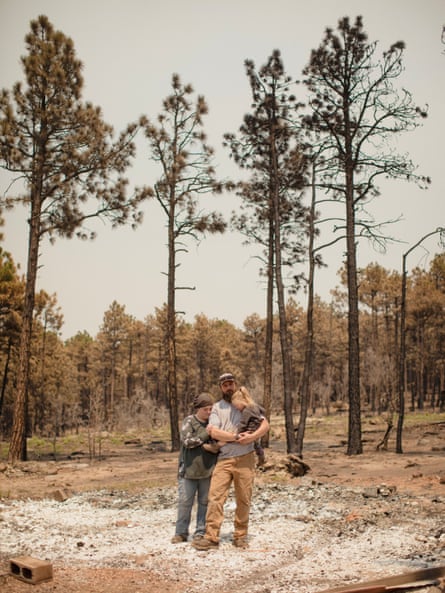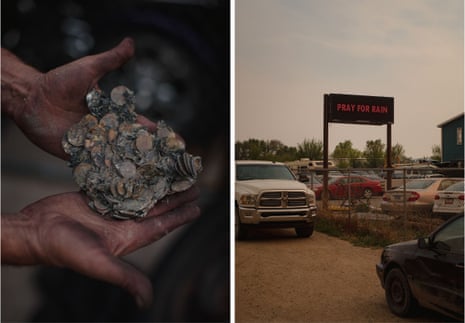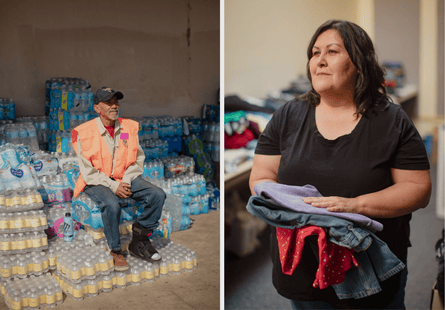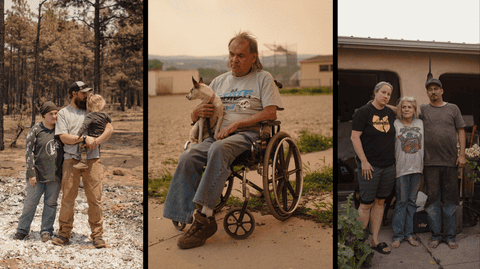For Kathryn Mahan and her husband, Jamie, the front steps of their home in the northern New Mexico village of Las Dispensas were a family touchstone. The couple built the house themselves in 2015 and fashioned the steps out of concrete blocks. Every year they photographed their daughter, Rayyah, on them – as Rayyah grew, the steps stayed the same.
The largest wildfire in New Mexico history has suddenly changed all that.
The family evacuated on 11 April as a rapidly growing blaze on the nearby mountain of Hermit Peak roared toward their home, driven by winds gusting up to 70 miles an hour. Three days later they returned to find the house and all their possessions had been reduced to ash. The only thing that remained were the concrete steps. Rayyah sat on the blackened blocks to pose for a photo as her parents documented the devastation.
The Mahans are one of many families who have lost everything in the huge blaze, now raging for more than a month. The Hermits Peak fire started on 6 April when a controlled burn conducted by the US Forest Service leapt its boundaries. It eventually merged with another wildfire called Calf Canyon, creating a mega blaze that has been largely unstoppable.

The Calf Canyon/Hermits Peak fire has since ballooned to nearly 300,000 acres, as of Tuesday, making it the largest to ever hit the state. And while there have been no fatalities, thousands of people have been displaced for weeks as firefighters struggle to get the blaze under control. These evacuees are depending on local shelters that serve the largely rural area north-east of Santa Fe and south of Taos where the blaze has left a trail of destruction.
Mahan is an ecologist who monitors forest health and was well aware of the threat of wildfire when she and her husband chose to build next to the Santa Fe national forest in the foothills of the scenic Sangre de Cristo mountains. The region is in a ponderosa pine ecosystem, like much of the upland south-west, and is especially vulnerable to wildfire in what has become the worst drought in 1,200 years.
The family took precautions to reduce the danger, such as building up defensible space around the house. But their fortifications were no match for a convergence of extreme weather conditions, including hurricane-force winds and an exceptionally dry winter that left forests and grasslands parched.
Many scientists believe these wind-driven spring wildfires are yet another unanticipated consequence of climate change in the American south-west.
“We are using every trick in the book to fight this thing, but the constant wind we have been experiencing day and night is unprecedented,” says Andy Lyon, a spokesperson for the south-west area incident management team. Lyon notes the fire experienced explosive growth the week of 9 May, when there was a 95-hour period of non-stop red flag conditions (the highest alert level from the National Weather Service for wildfire danger), including 50-60mph winds.
And while the winds have died down somewhat over the past few days, record high temperatures predicted for this week will continue to challenge firefighting efforts. The fire remains only 26% contained, as of Tuesday.
“There are so many things going against us,” says Lyon.
Coming together in a crisis
The fire is wreaking destruction on a culturally unique part of the south-west that was once the remote northern fringe of the Spanish empire, in the 17th century. Descendants of those Spanish colonizers continue to live on family homesteads that have been passed down for generations.
The mostly unincorporated, centuries-old communities are nestled in stream-cut valleys and mountain foothills surrounded by national forest. Many residents are older, have lived their entire lives in the region, and take pride in their culture of self-sufficiency and connection to the land. Lyon says it has been hard to convince many of them to leave their homes amid the fire threat.

In Las Vegas, a town of 13,000 and the largest in the region, displaced residents have been gathering at a shelter in an old middle school. The shelter was established by the Red Cross after the first evacuations in early April. Now led by an army of local volunteers, it provides breakfast, lunch and dinner to 100-200 people a day.
On a hot, windy morning last week, the air was hazy with smoke and stray black embers occasionally fell from the sky. The middle school resembled a fast-food drive-through as vehicles waited in line to reach the front entrance. Pickup trucks arrived with pallets of water and toilet paper that were promptly unloaded by national guard troops. Evacuees pulled up in cars with belongings piled to the ceiling and pets in crates. They were looking for dog food, open campgrounds and information on when they could get access to their homes.
Inside, the non-profit World Central Kitchen served meals cooked by local restaurants. The gym was filled with pallets of food and cots were set up in the corner. Toys, strollers and clothes lined a wall. T-Mobile was handing out phones with 30 days of free service, and the Federal Emergency Management Association was set up in a classroom to help people fill out disaster relief forms.
Ruben Garcia, 85, has been living at a hotel in Las Vegas, New Mexico, since he was evacuated from his home more than a month ago. He is from the village of Rociada, 27 miles north-west of Las Vegas, and lives on 100 acres that have been in his family for multiple generations. Garcia’s house was spared by the fire but barns and farm equipment were destroyed. Rociada remains under mandatory evacuation while crews continue to put out wind-whipped spot fires.

“I have had a rough time lately,” Garcia said as he ate lunch with his younger brother Leo at the shelter. Soon after being evacuated, Garcia fell and injured his ribs, compounding existing health conditions. His wife died last year.
“Rociada is the most beautiful place in the world,” Garcia said, longing to get back to his familiar surroundings. “It is in the mountains and full of water.”
Garcia’s son Michael, who lives in Denver, says going to the shelter for a hot meal and conversation with fellow evacuees is currently the one bright spot in his father’s life. “He and Leo are there every day,” says Michael. “They like to visit with people they know who are also displaced.”

While about 20 displaced people sleep at the shelter every night, it is also a lifeline to hundreds more who, like Garcia, come for hot meals, supplies and other essential services.
An older man walked up to the shelter entrance with a scrap of paper that contained three hand written phone numbers. He had just been evacuated from the community of Chacon and did not have a cellphone or a place to go. “Can you call my friend Larry?” he asked Janna Lopez, a resident who runs the shelter along with a team of local volunteers.
Lopez tried the numbers but none were in service.
“Sir, don’t worry,” Lopez said. “You should go inside and get a hot meal. We will take care of you.” Then she repeated her favorite Spanish saying, “A barriga llena, corazón contento”: full belly, happy heart.

Lopez and about 50 other shelter volunteers have been working 12 hours a day every day for more than a month. Many are evacuees themselves and some, like Andrew Vigil, have lost everything in the fire.
Vigil said he and his wife had worked non-stop for three years to earn enough money to buy one acre of land in the village of Tierra Monte. Vigil built a small cabin on the property and they also had a 24ft Winnebago. It was all destroyed in late April. Like most victims of the fire, they did not have insurance, meaning they’ll have to bear the full cost if they choose to rebuild.
“When I went back to see the place, my gut was torn out of me,” said Vigil as his eyes filled with tears.
Not long after evacuating, Vigil came to the Las Vegas shelter for lunch. Since then, he has been volunteering at the shelter every day for 10-12 hours.

“It helps me to be here,” he said last week as he manned the front entrance to greet arriving evacuees. “I’m used to doing stuff and I want to go forward. I don’t want to go backward because there is nothing left for me to go back to.”
‘Eventually a fire will come to your town’
It will be hard, if not impossible, for many longtime residents in this rural part of New Mexico to recover from the destruction. San Miguel and Mora counties, where most of the fire is located, have poverty levels of 20%. There is the financial barrier of trying to rebuild without the support of insurance as well as the environmental hazard of an increasingly severe fire season.
“A spring fire season adds a whole new level of complexity to the problems caused by climate change in the south-west,” says Andrew Sanchez Meador, executive director of the Ecological Restoration Institute at Northern Arizona University. “Up until the last decade, wind-driven fire events in ponderosa pine forests were unprecedented.”
Meador says one of the most important preventive measures is to reduce the fuel that a fire can consume. The ponderosa pine forests in northern Arizona and northern New Mexico are like tightly packed tinder boxes after a century of fire suppression, and the institute has long championed mechanical thinning and prescribed burns to get rid of excess fuel and reduce fire danger.
But with record windy and dry conditions, the timing for conducting prescribed burns on national forest lands located near residential communities is becoming increasingly tricky. Officials with the Santa Fe national forest have apologized for choosing the wrong day for their burn that inadvertently started the Hermits Peak fire.

While Kathryn Mahan is grieving the loss of her home, she takes the environmental hazards in stride. “For people now living in the rural west, the risk of wildfire will never go away,” she says. “It is like living in tornado country. Eventually a fire will come to your town.”
Mahan and her husband did not have insurance but they have decided to rebuild. The concrete steps will once again be part of a house. Their connection to the community is more powerful than the threat of wildfire.
“Everybody is taking care of everybody here,” she says. “This is where we belong.”
